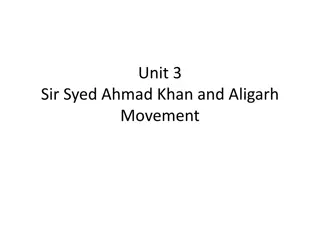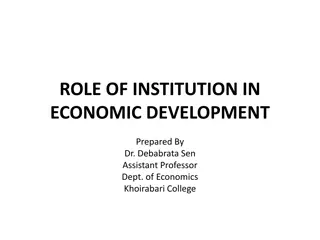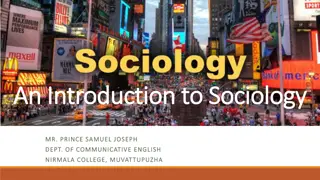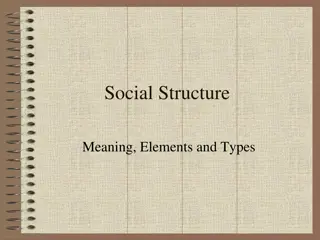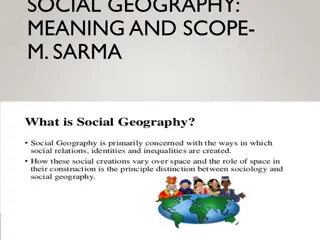Understanding Social Institutions: An Introduction by Imran Ahmad Sajid, PhD
Discover the concept of social institutions through Dr. Imran Ahmad Sajid's explanation. Explore how institutions are established practices that shape complex social forms, distinguishing between institutions and conventions, and their relation to society and culture. Delve into the role of institutions as organizations and meta-institutions that organize other societal structures.
Download Presentation

Please find below an Image/Link to download the presentation.
The content on the website is provided AS IS for your information and personal use only. It may not be sold, licensed, or shared on other websites without obtaining consent from the author. Download presentation by click this link. If you encounter any issues during the download, it is possible that the publisher has removed the file from their server.
E N D
Presentation Transcript
SOCIAL INSTITUTIONS: Introduction to the Concept IMRAN AHMAD SAJID, PhD
Dictionary meaning Institution = established practice: an established law, custom, or practice Established:
Definitions Complex social forms that reproduce themselves (Seumas Miller, 2011). SOCIAL: relating to the way in which people in groups behave and interact FORM: the shape or appearance of a thing that makes it identifiable
Institution vs Convention etc. Conventions, Rules, Social Norms, Roles and Rituals Less complex social forms They are the constitutive elements of institutions. Conventions: usual way of doing things
Institution vs Society & Culture Society and Culture more complex and more complete social entities Institution is typically a constitutive element of society or culture SOCIETY: Society refers to people who interact in a defined territory and share a culture (John J. Macionis) CULTURE: Culture is the ways of thinking, the ways of acting, and the material objects that together form a people s way of life (Macionis, 2012.p.54).
Institutions as Organizations Some institutions are organizations such as government Some institutions are not organizations such as Urdu Language or Barter system (which involves individuals not organizations) Organization: relationship of components: the relationships that exist between separate components in a coherent whole
Meta Institutions Meta Institutions*-- they are institutions that organise other institutions. For example, governments are meta-institutions. The institutional function of a government consists in large part in organising other institutions (both individually and collectively); thus governments regulate and coordinate economic systems, educational institutions, police and military organisations and so on, largely by way of (enforceable) legislation. *Higher Institutions
Properties of Institutions 1. Structure 2. Function 3. Culture 4. Sanction
Role 4 1. Structure & Function Role2 Role5 Role1 Role3 Role6 Roughly speaking, an institution consists of an embodied (occupied by human persons) structure of differentiated roles. These roles are defined in terms of tasks, and rules regulating the performance of those tasks. Moreover, there is a degree of interdependence among these roles.* Further, these roles are often related to one another hierarchically, and hence involve different levels of status and degrees of authority. Finally, these roles are related to one another in part in virtue of their contribution to (respectively) the end(s) or function(s) of the institution; and the realisation of these ends or function normally involves interaction among the institutional actors in question and external non-institutional actors. The constitutive roles of an institution and their relations to one another can be referred to as the structure of the institution.
3. Culture Aside from the formal and usually explicitly stated, or defined, tasks and rules, there is an important implicit and informal dimension of an institution roughly describable as institutional culture. This notion comprises the informal attitudes, values, norms, and the ethos or spirit which pervades an institution. Culture in this sense determines much of the activity of the members of that institution, or at least the manner in which that activity is undertaken.
4. Sanctions It is sometimes claimed that in addition to structure, function and culture, social institutions necessarily involve sanctions. It is uncontroversial that social institutions involve informal sanctions, such as moral disapproval following on non-conformity to institutional norms.
Rom Harre (1979: 98): An institution was defined as an interlocking double- structure of persons-as-role-holders or office-bearers and the like, and of social practices involving both expressive and practical aims and outcomes. He gives as examples (Harre 1979: 97) schools, shops, post offices, police forces, asylums and the British monarchy.
J. ANTHER Institution refers to established patterns of behaviour which make up a rule-constrained order within which individual act. An institution is composed of roles, actors, rules, objectives and communication facilities. Encyclopedia of Social Science (Sociology)






